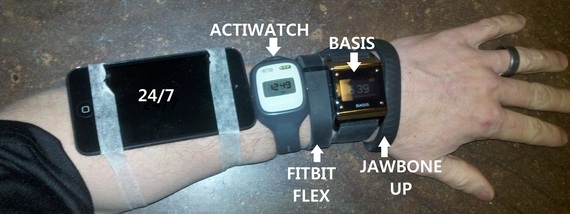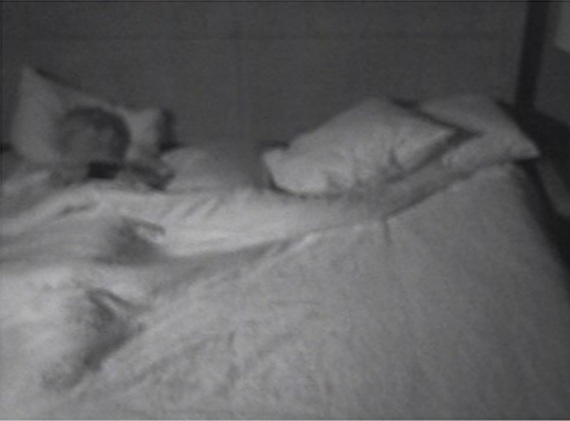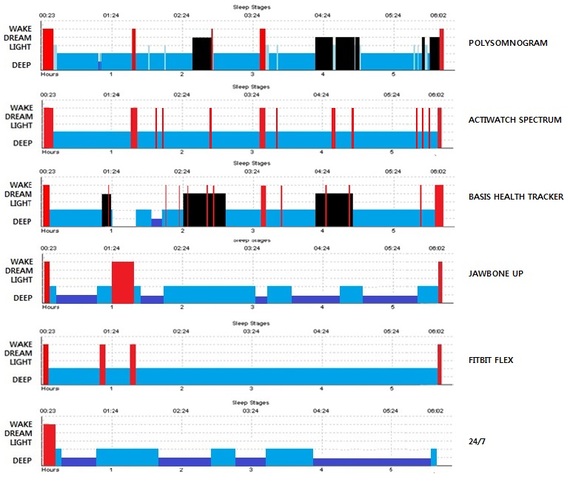I have avoided writing about personal fitness/sleep monitors for many reasons. The media is saturated with articles about these devices as writers wear them around and offer their opinions. Another test drive article seemed unnecessary. My biggest reluctance for weighing in on the matter is that I fundamentally like what they stand for. As a sleep specialist, I have a great appreciation for the importance of sleep. As a physician, I feel personal fitness is the cornerstone of good health. If wearing a piece of plastic around one's wrist motivates an individual to sleep more at night or be less sedentary during the day, why should I mess with that?
This article grew out of my own curiosity about the accuracy of these devices in characterizing sleep as well as some issues that arose as I helped a professional sports organization set up a sleep monitoring system for its athletes. In dealing with the patients I see and the athletes I work with, there are often significant misconceptions about these monitors as they pertain to sleep. Explaining how these devices work and what they are and are not capable of was easiest if I used my own experiences as illustrations.
Before I get into the details of these devices, ground rules need to be established. There are many ways to compare these products: best battery life, best looking, best interface with social media so you can brag about how much you are running every day... the list is endless. While I did count each of my steps for an entire day to see which device was most accurate, this article will focus almost entirely on how well they track sleep.
To understand these monitors, it is important to know how they work. Most of the devices available to consumers use small motion detectors called accelerometers to detect movement. The simple theory is movement equals wakefulness and prolonged lack of movement equals sleep. This technology, known as actigraphy, has been around for decades and is a useful tool for mapping general patterns of sleep. While some companies claim that they can provide detailed sleep quality measures with actigraphy, to do so would be the equivalent of determining how well a car is driving by its odometer reading alone.
To put these devices to the test, I needed a gold-standard evaluation of my sleep quality. To achieve that, I underwent a true sleep study. This combination of brain wave tracings, muscle-tone evaluation and eye-movement analysis, along with a live audio/video of my sleep allowed me to see exactly what was happening during my slumber.
In this experiment, I evaluated a wide range of popular devices:
Philips Actiwatch Spectrum ($600): Philips has made actigraphy devices for many years and in my opinion, they are the gold standard for research-level actigraphy. The units are very durable and waterproof and require no input from the wearer. The device measure movement and light. The company makes no claims about differentiating light sleep, deep sleep, or REM sleep.
Basis Chrome ($199): In addition to measuring movement, the Basis also measures heart rate, skin temperature, and perspiration. With these added parameters, the Basis claims to not only measure sleep and sleep stages, but does not require the wearer to indicate sleep.
Jawbone Up ($115): This uniquely designed device simply plugs into your iTouch or phone and syncs all of your activity and sleep data. A button at the end of the bracelet is pressed to indicate sleep start and sleep stop.
FitBit Flex ($99): This simple device tracks steps and sleep and features an effortless wireless interface. Five taps are required to turn on its sleep monitoring. Once awake the next morning, simply tap five more times to indicate the end of sleep.
24/7 ($0.99): This app available from the iTunes store utilizes the actigraphy technology in your iTouch or smart phone and uses it to track sleep. While it can simply be placed on the bed, it is suggested that it be affixed to your arm for greater accuracy. Once you hit the sack, simply switch it into sleep mode.
The experiment began when I arrived at the sleep center with all of these devices strapped to my non-dominant arm. My technician Jamie was a registered polysomnographic technician with years of experience. She was in charge of hooking me up for the study and independently staging my sleep.
After being hooked up, I got into bed, tapped on the FitBit, pushed the button on the Jawbone, and initiated the sleep monitoring feature of the 24/7 app (the picture above is from the video of the sleep study). As I turned out the light, I felt like I fell asleep fairly quickly. My night was uneventful except for a muscle tone lead falling off during the night with Jamie quickly fixing it.
Here are the results with my sleep study findings on top. Red indicates wakefulness, black is REM sleep, and blue indicates light (light blue) to deep (darker blue) sleep. I have translated the output of all of the devices into a common visual reference to allow for easier comparison. While the "look" of the data has changed, the data content has not.
Based upon my sleep study, my total sleep time was 5 hours and 22 minutes. The time it took me to fall asleep from lights out (sleep latency) was 9 minutes. I spent 18.1% of the night in REM sleep, 5.6 percent in N1 sleep (transitional sleep), 75.8 percent in N2 sleep (light sleep) and 0.5 percent in N3 sleep (deep sleep).
The Actiwatch Spectrum did a great job of separating sleep and awakenings as the wake periods it detected matched up well with wakefulness from the sleep study. Without user input it detected sleep onset well (no doubt in part because it senses light). For extended monitoring of sleep patterns, this device is a safe bet.
The Basis did an amazing job of characterizing my sleep stages. Even without my indication that I had gone to sleep, the sleep onset was almost perfect, and it accurately detected two of my three REM cycles. The Basis did not detect my final REM cycle and it added a REM cycle early in the night. The arousals during my second REM cycle were spot on as was my awakening around 3:30 a.m. when my chin lead fell off. I am floored that this device accurately staged sleep based solely upon wrist inputs.
The Jawbone produced an impressive amount of data. It estimated my total sleep time as being 4 hours and 31 minutes and my sleep latency as 11 minutes. The device attempted to differentiate between light sleep (2 hours and 4 minutes in my case) and deep sleep (2 hours and 26 minutes), but does not account for REM/dream sleep. How this device defines deep sleep and dream sleep is unclear, but I'm guessing it is simply combining deep sleep and REM sleep under the title "deep sleep." In looking at the data, the results of the Jawbone bear little resemblance to my actual night of sleep.
What I like about the FitBit is that it does not pretend to be able to differentiate between sleep stages. It instead focuses on detecting periods of disturbed sleep or wakefulness during the night. While it underestimated my sleep latency a little, it did manage to detect an awakening that occurred around 1:50 a.m. Strangely, it seemed to label the small segment of deep sleep I managed to achieve as being an awakening as well.
Finally, the 24/7 app for my iTouch seemed to generate a completely arbitrary series of stages during the night. It did have the added feature of recording unusual sounds and even captured a brief period of snoring. While it also recording Jamie coming into my room to fix a lead, it unfortunately labeled the event as deep sleep. On the plus side, this device was the surprising winner in terms of counting steps, being off by only 10 steps during my day. (Note: this device was in my right pants pocket during the day and not on my wrist like the others.)
With only one night of data collected, I am reluctant to declare winners and losers as I think that based upon their individual costs and abilities, each has its place in fitness and sleep monitoring. From a purely sleep monitoring perspective, the Basis seemed to distinguish itself from a perspective of accuracy. The bottom line is that any device on your wrist that makes you think twice about staying up too late is a good thing.
Photography by Maeve Janelle.



